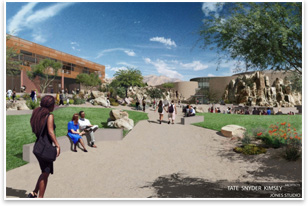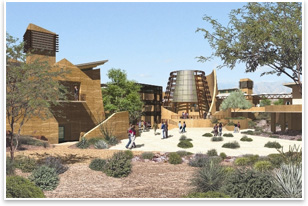Sustainability, the Straw that Stirs Las Vegas’ Springs Preserve
Non-gaming attraction celebrates Las Vegas’ natural resources, history
by Russell Boniface
Associate Editor
Summary: Green living and green building are the theme of the new Las Vegas Springs Preserve, a 180-acre, $250 million cultural attraction located off the Las Vegas Strip on a natural springs site. The preserve is composed of 11 buildings constructed of environmentally friendly, recycled, or re-used materials, such as straw bale, soda bottles, and sustainable lumber. The complex, applying for LEED® Platinum status, forms a destination of sustainability museums, botanical gardens, and trails. Las Vegas-based Lucchesi and Galati Architects is the primary designer. The preserve will open in May 2007.
 The Springs Preserve site became a national historic site in 1978 because it is considered the birthplace of Las Vegas. The concept for the Springs Preserve attraction was originated by the Las Vegas Valley Water District, which owns the land. The preserve is financed by the district, $48 million dollars from federal land sales, and private donations. The Springs Preserve site became a national historic site in 1978 because it is considered the birthplace of Las Vegas. The concept for the Springs Preserve attraction was originated by the Las Vegas Valley Water District, which owns the land. The preserve is financed by the district, $48 million dollars from federal land sales, and private donations.
The heart of the project is a “green” museum called the Desert Living Center, a complex of five buildings constructed of rice straw bale, the largest straw-bale construction project in the country. Sustainable components of the living-center and preserve development include:
- Carpets made from recycled soda bottles
- A 35-acre natural wetland that reclaims on-site wastewater
- Certified sustainable lumber
- Rammed-earth walls
- Reclaimed timber
- Radiant floor heating
- Towers for evaporative cooling systems
- Low-VOC paints, furniture, fabrics, and wood.
Desert history meets sustainability
Jeff Roberts, AIA—the Lucchesi and Galati Architects project manager and lead architect—says the preserve buildings will serve as an interactive sustainable exhibit. “I hope the sustainability angle will attract people to visit. There’s a new generation, especially in this region, looking for energy alternatives. Interest in sustainability is turning.”
 Jesse Davis, public relations and marketing manager at the preserve, says sustainability is half the attraction. “The other half is the historic element. We’re breaking through the stereotypical mold of Las Vegas history that most people associate with the Strip by showing how the springs originally drew people here to this valley.” If not for the springs at the preserve site, explains Davis, Las Vegas might be located elsewhere. Jesse Davis, public relations and marketing manager at the preserve, says sustainability is half the attraction. “The other half is the historic element. We’re breaking through the stereotypical mold of Las Vegas history that most people associate with the Strip by showing how the springs originally drew people here to this valley.” If not for the springs at the preserve site, explains Davis, Las Vegas might be located elsewhere.
“Conceptually, our project was created to promote water conservation because of the scarcity of water in this city,” Davis points out. “But since conservation extends into a broader living ethic today, the preserve’s model of sustainability will extend far beyond just conserving water.”
Looking to past desert architecture
Roberts explains that the project design kept the style of the preserve buildings small and indigenous to the area. “We looked at principles from past desert cultures that could teach us, such as Pueblo architecture and how, for example, in their cliff dwellings they designed for the harvest. We took the way they designed for sun, wind, and weather and tied that into our design. An example is our cool towers for passive cooling and a radiant heating system of hot solar water heating slabs, which in turn are cooled by the rammed earth. There are no mechanical systems in the building.”
Sustainability to put a spring in visitors’ steps
Rather than talking about green buildings, the preserve takes visitors through each design element. “We aren’t just developing LEED-rated buildings for the sake of it,” declares Davis. “We’re interpreting the buildings for visitors. We will have exhibit walks taking visitors through the buildings while explaining the ‘green’ products that went into them. Visitors will also learn the operations required to maintain the LEED rating.”
 Straw bale walls for all five Desert Living Center buildings and recycled soda bottles used for carpeting throughout the Preserve are examples of the sustainable elements visitors will experience firsthand. “The rice straw is a great insulator, eliminates agricultural waste, and great for keeping sound and heat out,” says Roberts. “There are many straw bale homes in the Southwest, so it’s appropriate for our design.” Straw bale walls for all five Desert Living Center buildings and recycled soda bottles used for carpeting throughout the Preserve are examples of the sustainable elements visitors will experience firsthand. “The rice straw is a great insulator, eliminates agricultural waste, and great for keeping sound and heat out,” says Roberts. “There are many straw bale homes in the Southwest, so it’s appropriate for our design.”
The project includes reused materials, such as support trusses in the Desert Living Center made of timber from an old railroad trestle bridge that crossed Salt Lake. “You can actually see the original markings in the wood,” enthuses Davis.
The meadows
Educational galleries, a design lab, dialogue centers, and teaching facilities will also celebrate sustainability. A 97,000-square-foot attraction of galleries and theaters called the Ori•gen Experience will showcase early Spanish inhabitants who called the preserve home. “Las Vegas means the meadows,” explains Davis. “Spanish explorers discovered the site. The preserve is the first destination to actually document that physically. We’re attempting to reveal the true origins of the city and be dedicated to today’s sustainable principles.”
“Everybody portrays Las Vegas as an opulent culture,” says Roberts. “If there is a sin here, you can find it. We’re fighting that trend. We want to teach people we can be as sustainable as any city.” |




